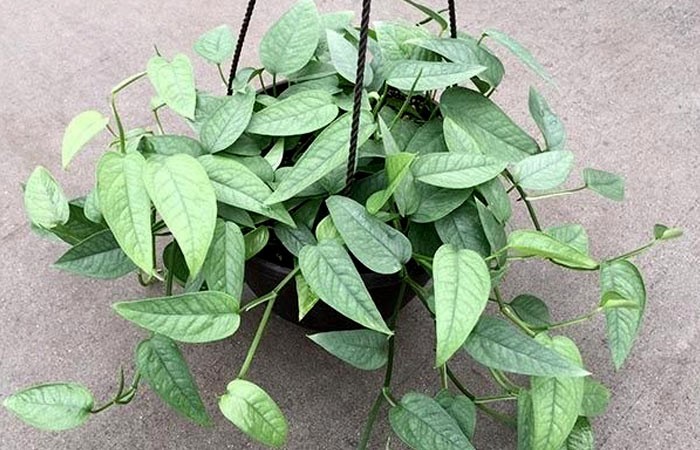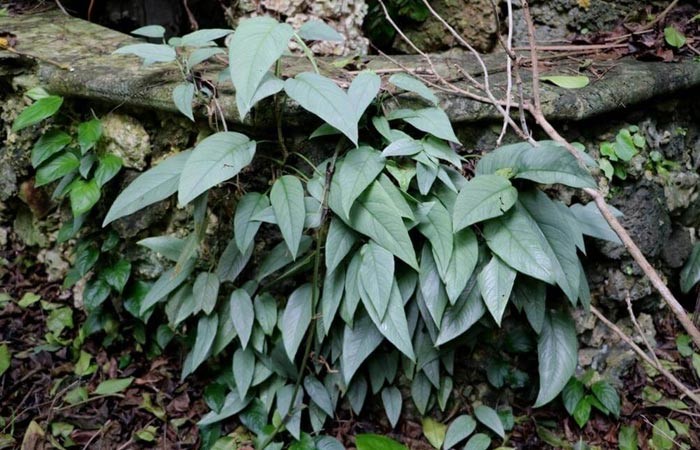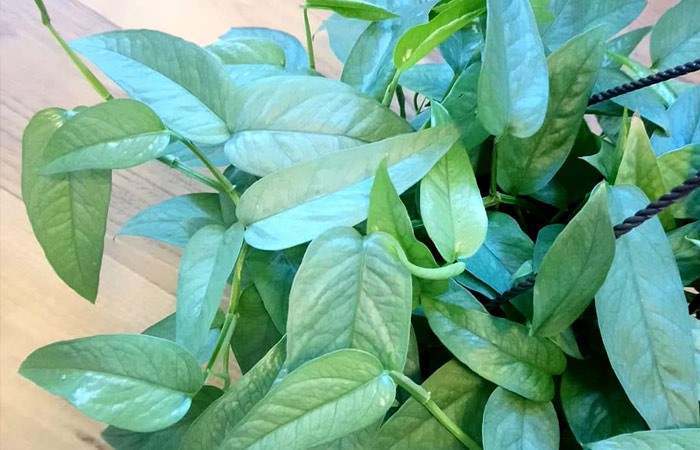Cebu Blue Pothos: How to Propagate and Care

Cebu Blue Pothos is an evergreen Pothos variation, known for displaying hues of blue in its leaves. Perfect for growing both indoors and outdoors, Cebu Blue Pothos can give a unique look to your space. Despite its striking appearance, Epipremnum pinnatum Cebu Blue Pothos care is very easy.
If you are considering to add this amazing houseplant to your garden or room, then it is a good idea to know a bit more about Cebu Blue Pothos. Below, we will describe this gorgeous plant, its requirements, how to propagate Cebu Blue Pothos, etc.
Cebu Blue Pothos: an Overview
This plant is perfect for beginner gardeners, as it is an evergreen houseplant and does not require constant care. Cebu Blue Pothos scientific name is Epipremnum pinnatum. This flowering plant is a member of the Araceae family and comes from the Epipremnum genus like other Pothos variations.
However, you may have also seen its name as Cebu Blue Pothos Philippines. This is because this plant obtains the “Cebu Blue” part of its name from the island of Cebu in the Philippines. You can easily find this plant in the indigenous perennial vines there, as well as in other Asian countries, some parts of Australia, and Europe.
As a tropical vine, Epipremnum pinnatum Cebu Blue Pothos can trail and climb various structures. Cebu Blue Pothos can grow from 4 to 40 feet tall outdoors. Indoors, its height will not go over 10 feet.
So if you prefer your Cebu Blue Pothos seeds to grow to their maximum size, plant them outdoors. But remember that it is primarily an indoor plant.
This attractive houseplant is also very versatile, adjusting very well to different conditions. Under the right lighting condition, the silvery-blue, shiny arrow-shaped leaves of Cebu Blue Pothos will glow beautifully. Despite significantly elevating the home decoration, this Pothos is notably low maintenance.
People know Cebu Blue Pothos Philippines by a few other names too, including Blue Pothos, Devil’s Ivy, Centipede Tongavine, Dragon-tail plant, Schindapsus aureum, and Tibatib in the Philippines. Also, kindly keep in mind that this plant is toxic to pets like cats and dogs, and children when ingested. Common symptoms include pain, swelling, and redness. More rare symptoms are difficulty breathing and vomiting.

Cebu Blue Pothos Growth Phases
The striking appearance of this houseplant is not the only unique thing about it. Cebu Blue Pothos from the Philippines actually has two different growth phases: juvenile and mature. These important phases determine the size and color of the Cebu Blue Pothos’ leaves and how it behaves or grows in general.
1. Juvenile (Young)
During the juvenile phase, Epipremnum pinnatum has notable silver or blue-grey leaves. This amazing and distinct display of colors is because that eaves of one Cebu Blue Pothos could have various shades including blue, bluish-green, green, and silver. Under bright light, these eye-catching shades look even more striking and attractive.
As we mentioned, this plant has long leaves that almost look like an arrow from 2 to 4 inches. When Cebu Blue Pothos Philippines is in the juvenile phase, people usually call it the “European house plant” since it is a popular houseplant in European houses for home decoration.
Regarding its behavior in this phase, a young Cebu Blue terrestrial is terrestrial and has the ability to grow without much support from the gardener. During this period, it can develop dangling vines if you have put it in a hanging basket.
2. Mature
During the second phase, you can see Cebu Blue Pothos fenestrations. When mature, the leaves take a greenish hue with zigzag cuttings going up to its mid-section. At this point, the leaves are similar to the fronds of a palm tree. In this phase, your plant turns into a natural climber and its leaves grow up to 4 inches.
Learn more about palm tree seeds and palm trees roots system
Keep in mind that these numbers are only for the plants that grow indoors. If you decide to grow your Epipremnum pinnatum Cebu Blue Pothos outdoors, you can expect bigger numbers compared to a regular indoor plant. The leaves would have different sizes as well. If grown indoors, the variegated Cebu Blue Pothos leaves usually grow up to 4 inches tall. However, these leaves could grow up to 30 inches outdoors.
Both indoors and outdoors Cebu Blue Pothos do not bloom. This is actually good news, due to the fact that controlling it indoors would become especially difficult if the growth is excessive. But do not worry, their beauty is still impressive even without blooms.

Cebu Blue Pothos Care
As we said, this charming plant is really easy to care. Below, you will find important tips about Cebu Blue Pothos care and its needs:
Soil
Any bagged potting mixes are suitable for your variegated Cebu Blue Pothos. However, we recommend choosing a well-draining, chunky mix with perlite or vermiculite and orchid bark (vermiculite holds moisture better than perlite). The pot that you pick for Epipremnum pinnatum Cebu Blue Pothos has an important effect on your plant’s growth.
If you use a hanging pot, your plant would possibly stay immature for a long time or for good. Because when hanging, the plant and does not have a good grasp on itself and starts to dangle. In this situation, there is no noticeable growth and even the leaves start shrinking. Hanging pots are great for decoration, but they stop the plant from developing.
A pot with some moss support is probably a better idea for a fine Cebu Blue Pothos care. In this case, your plant will climb and thrive into a mature and elegant plant in no time. When outdoors, particularly in a forest, Epipremnum pinnatum climbs trees to become strong and beautiful.
Light
This evergreen plant loves locations with medium lighting. But if are interested that your Epipremnum pinnatum displays lush and vibrant foliage, provide a good amount of indirect light for it. But do not ignore the fact that it needs some periods of darkness too. Do not place the Cebu Blue Pothos Philippines in direct sunlight too.
If you want to take it outdoors for a healthy amount of light, the light needs to be filtered. Under a tree or a bigger plant is an excellent choice in this situation. If you cannot find a bigger plant, place the Blue Pothos close to your window during the day. These steps are recommended when your unique plant is still growing.
Like other indoor plants, variegated Cebu Blue Pothos would also benefit from occasional direct exposure to the early morning sun during winters. Do not put your plant in the sun during the afternoons or when it is at its peak.

Water
Similar to light, Cebu Blue Pothos Philippines does not need too much water. However, sprinkling it with some water will lead to true elegance. You do not any special watering techniques for Epipremnum pinnatum; simply water it like other indoor plants.
Between irrigations, let your plant soak completely and dry out a bit (the top inch). After watering, let the excess water escape through the drainage hole completely and empty the saucer immediately.
If the soil looks drenched all the time, you have been watering your Cebu Blue Pothos more than you should. On the other hand, if the leaves are yellow or the foliage looks wilted, you are not watering the plant as much as it needs.
Temperature and Humidity
Cebu Blue Pothos Philippines can survive at room temperature and the typical humidity of a regular household. So if you are planning to keep it indoors, your plant will be fine. However, you are living in a dry region (do not forget the effect of air conditioning as well), we suggest considering a humidifier or a pebble tray.
A pebble tray or a pebble saucer is a simple gardening tool that people often use for indoor plants. To make this tray, all you need is a tray, some pebbles, and water. Then, put your Cebu Blue Pothos pot in the tray for proper humidity.
Feeding
Feeding Cebu Blue Pothos is not much of a luxury. In fact, fertilization is a necessity during this plant’s growing years. Considering that your plant can also grow on its own, you do not need to fertilize it much. You will even need less fertilization if the potting mix already contains slow-release fertilizer in it.
A good fertilizer provides a mix of both macronutrients (nitrogen, phosphorus, and potassium) and micronutrients (calcium, magnesium, iron, manganese, zinc, sulfur, boron, chlorine, and copper).

How to Propagate Cebu Blue Pothos
Similar to Cebu Blue Pothos’ care, propagating it is convenient too. There are two different methods for Cebu Blue Pothos propagation: the single leaf method or Cebu Blue Pothos cuttings.
Cebu Blue Pothos Cuttings
To propagate using this method, simply make cuttings a few inches in length and then plant them in soil or put in water. Both soil and water are suitable, but if you prefer to see the roots grow, propagate the Cebu Blue Pothos cuttings in water. When the roots have grown to a healthy level, you can move them to a hanging basket or a pot.
When harvesting the Cebu Blue Pothos cuttings, make sure that they have at least a couple of nodes (the part where the leaf connects to the stem). Because the roots will grow from the nodes. Pot the Cebu Blue Pothos cuttings once you notice root growth. If you wait, the growth pace will decrease.
If putting the Cebu Blue Pothos cuttings in the water and then planting it seems too much trouble, you can skip that part and directly transfer it to a pot.
Single leaf Cebu Blue Pothos Propagation
Cebu Blue Pothos propagation is possible with a single leaf too. First, cut one leaf with one inch of its stem and one node. Use a sharp and sterilized knife for cutting. Place the leaf’s stalk upright in a small jar with water.
Soon, tiny roots will develop from the node. However, compared to the first method, you may need to wait more before you could transfer it to a pot.
Epipremnum Pinnatum Common Issues
- Yellow Leaves and Unusual Shape: Not enough water and light can make the leaves noticeably flatter than normal and yellowish. To prevent this problem, water your variegated Cebu Blue Pothos at regular intervals.
- Brown Leaves: This issue indicates excess sunlight exposure. Feeding too much and over-watering could also brown the vibrant leaves of your plant. To avoid the issue, make sure that your Epipremnum pinnatum does not get too much sun. You do not need to cut out the sun completely; simply manage its sun exposure.
- Pests: Mealybugs, spider mites, and other common pests can cause problems for your charming plant. Regularly wiping the leaves with a clean, damp cloth and spraying it with pesticides can prevent and solve this matter.
- In this post:
- Cebu Blue Pothos: an Overview
- Cebu Blue Pothos Growth Phases
- Cebu Blue Pothos Care
- How to Propagate Cebu Blue Pothos
- Epipremnum Pinnatum Common Issues



